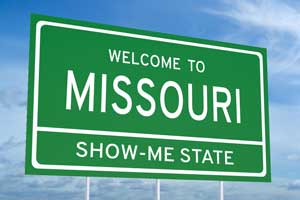Why Missouri Received Two Federal Reserve Banks

This is the final post of a three-part series discussing the founding of the Federal Reserve System. Today’s post examines why Missouri received two Reserve banks.
As our previous blog post discussed, banker preferences and economic strength of cities seemed to weigh heavily on the decisions of the Reserve Bank Organization Committee (RBOC), which selected where Federal Reserve banks would be located and how the district boundaries would be drawn.
Still, many believe (then and now) that politics played a significant role in influencing these decisions. A article by Vice President and Deputy Director of Research David Wheelock examined these claims, focusing on one in particular: the fact that Missouri received two Reserve banks (in St. Louis and Kansas City).
Economic and Political Considerations
Wheelock wrote: “The RBOC’s announcement brought outcries from several cities that had unsuccessfully sought Reserve Banks and charges that political considerations—especially Democratic Party interests—had unduly influenced the committee’s decisions.”
Wheelock pointed out that some research suggests that political influence indeed played a role. For example, one researcher noted that Missouri Senator James A. Reed and Oklahoma Senator Robert Owen (who was chairman of the Senate Banking Committee and had sponsored the Federal Reserve Act) appealed directly to the White House for Kansas City getting a Reserve bank.1 (For more examples of potential political influence, see Wheelock’s article “Economics and Politics in Selecting Federal Reserve Cities: Why Missouri Has Two Reserve Banks.”)
However, other research suggests that both Kansas City and St. Louis could stand on their own merits. Another paper Wheelock cited suggested that “partisan connections at best smoothed the way for selecting two Missouri cities. In this case, the choice more likely reflected the region’s political economy (with Kansas City looking westward and St. Louis to the east) and the desire to curry support of the most active banking communities (given St. Louis’s status as a major financial center).”2
Wheelock wrote: “Thus, apart from political connections, it seems conceivable that strong cases could be made for both St. Louis and Kansas City on the basis of economic considerations and the preferences of the Fed’s future member banks.”
St. Louis
Wheelock noted that the support for St. Louis receiving a Reserve bank was not surprising. St. Louis was the nation’s fourth largest city at the time and was one of three cities to be designated a central reserve city (along with New York City and Chicago).
Wheelock also noted that Reserve banks needed strong transportation and communication services to serve their member banks. He wrote: “At the confluence of the Missouri and Mississippi Rivers and with service from 26 trunk rail lines, St. Louis was one of the nation’s premier transportation hubs.”
A survey conducted by the RBOC also appeared to heavily influence the locations of Reserve banks. National banks were asked to name their top three choices for the location of their Reserve bank, as well as eight to 12 recommendations for Reserve bank locations throughout the country.
St. Louis was in the top 10 in first-choice votes, received the third-most first-, second- and third-place votes overall (behind Chicago and New York City) and was named first-choice by banks in 11 states (also third-most behind Chicago and New York City). (For more details on the results of this survey, see Wheelock’s paper “Economics and Politics in Selecting Federal Reserve Cities: Why Missouri Has Two Reserve Banks.”)
Kansas City
St. Louis’s selection may not have been surprising, but Kansas City’s selection was somewhat controversial. After the RBOC announced the locations of the Reserve banks, it followed up with a report focusing on some of the most controversial decisions, including selecting Kansas City over Denver, Omaha or Lincoln.
Kansas City received considerable support from bankers according to the RBOC’s survey. Wheelock wrote: “The extensive support for Kansas City, however, was viewed as something of a surprise.” It received the fifth-most first-choice votes (506) among all cities, well ahead of its chief rivals Denver (136 votes), Omaha (218) and Lincoln (22).3
Wheelock also noted that Kansas City had better transportation linkages and business connections within its district than its rivals. Kansas City was close to St. Louis in terms of transportation, with 16 trunk rail lines, 32 subordinate lines and 260 daily passenger trains. Also in its favor, Wheelock noted that Kansas City was a correspondent banking center.
Conclusion
Wheelock concluded: “We’ll never know the extent to which political considerations played a role in the selection of Kansas City, St. Louis, or both cities for Reserve Banks, but on the basis of both the preferences of bankers and the economic criteria for the placement of Reserve Banks, both cities deserved serious consideration.”
Notes and References
1 Todd, Tim. Confidence Restored: The History of the Tenth District’s Federal Reserve Bank. Kansas City, MO: Federal Reserve Bank of Kansas City, 2008.
2 Binder, Sarah; and Spindel, Mark. “Monetary Politics: Origins of the Federal Reserve.” Studies in American Political Development, April 2013, Vol. 27, Issue 1, pp. 1-13.
3 Kansas City was fifth when votes for Minneapolis (370) and St. Paul (94) are combined and also include votes saying either city would be a first choice (44).
Follow the Series
- Why the Federal Reserve Was Founded
- How the Federal Reserve System Was Formed
- Why Missouri Received Two Federal Reserve Banks
Additional Resources
- Review: Economics and Politics in Selecting Federal Reserve Cities: Why Missouri Has Two Reserve Banks
- Annual Report: 100 Years of Service
- On the Economy: Why St. Louis Received a Federal Reserve Bank
- On the Economy: How the Fed’s Regional Structure Affects Monetary Policy
Citation
ldquoWhy Missouri Received Two Federal Reserve Banks ,rdquo St. Louis Fed On the Economy, July 28, 2016.
This blog offers commentary, analysis and data from our economists and experts. Views expressed are not necessarily those of the St. Louis Fed or Federal Reserve System.
Email Us
All other blog-related questions

